How to Brew Green Tea Loose Leaf: A Step-by-Step Guide for Perfect Flavor
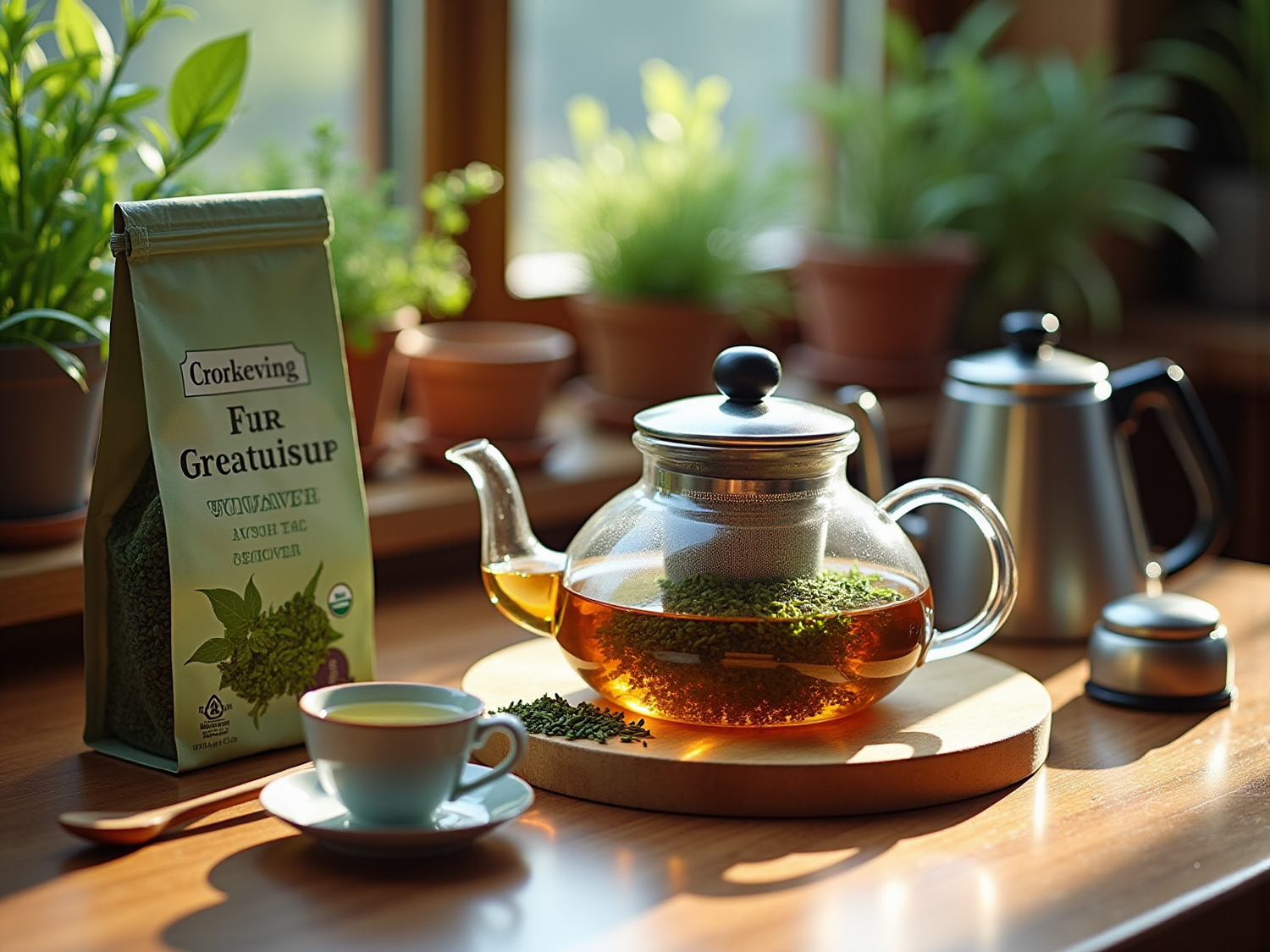
Overview
Brewing loose leaf green tea can be a delightful experience, especially when you prioritize high-quality organic leaves. Imagine the warmth of a perfectly brewed cup, crafted with care. To achieve this, it's important to measure your tea leaves accurately and pay close attention to water temperature and steeping time.
Maintaining a water temperature between 160°F to 185°F is essential. This not only prevents bitterness but also enhances the tea's natural flavors, creating a soothing experience for your senses. Steeping for just 2 to 3 minutes allows the leaves to release their goodness without overwhelming your palate. Expert recommendations and research support these practices, ensuring that your tea is both enjoyable and healthful.
As you embark on your tea journey, consider the benefits of incorporating loose leaf green tea into your routine. It’s not just about the taste; it’s about nurturing your well-being. So why not take a moment to explore the world of organic teas? You might just find a new favorite that resonates with your wellness goals.
Introduction
In the quest for the perfect cup of loose leaf green tea, your journey begins long before that first delightful sip. Selecting high-quality ingredients and utilizing the right tools can truly enhance both the flavor and the health benefits of this cherished beverage. Did you know that the ideal water temperature and proper steeping time play a crucial role? Every detail contributes to unlocking the tea's rich potential.
As more of us seek unique flavors and health-conscious options, understanding the nuances of brewing green tea becomes essential. This article will gently guide you through the essential tools, step-by-step brewing instructions, and tips for avoiding bitterness. Our aim is to ensure that every cup not only delights your palate but also supports your overall wellness. So, let’s embark on this flavorful journey together!
Essential Tools and Ingredients for Brewing Loose Leaf Green Tea
To brew the perfect cup of loose leaf green tea, gathering the right tools and ingredients is essential for enhancing both flavor and health benefits.
Start with premium organic green tea loose leaf. Choosing USDA Organic and KSA Kosher certified blends enhances your brewing experience while ensuring sustainability and purity. Each batch is third-party lab tested, so you can trust that every sip is pure and reliable. As tea expert Quentin Vennie shares, "You can use pu erh tea leaves for up to five infusions, meaning you can steep the same leaves five times, and when you have a great tea, it will get better each time you steep it."
Next, consider your teapot or infuser. A teapot with a built-in infuser or a separate tea infuser is crucial. This allows the leaves to expand fully, releasing their rich flavors and beneficial properties. For better control over brewing time, opt for a brew basket instead of small tea balls or novelty infusers, with a preference for stainless steel versions. These tools align with Gardenika's commitment to quality and sustainability.
A kettle that heats water to precise temperatures is ideal for brewing green tea, as different varieties require specific heat levels for optimal extraction. Kettles with temperature control features can make a significant difference in achieving the perfect brew. While investing in high-quality brewing tools, like Yixing clay pots, can be costly, they truly enhance the brewing experience.
Accurate measurement of tea leaves is vital. A general guideline is to use about 1 teaspoon (approximately 2 grams) of tea per 6 ounces of water, ensuring a balanced flavor profile.
Utilizing a timer is essential to monitor steeping times, preventing over-brewing which can lead to bitterness. Proper steeping times vary by tea type, so refer to specific guidelines for best results.
Finally, select your favorite cup or mug to savor your freshly brewed tea, enhancing the overall experience.
Utilizing these tools not only enhances the brewing process but also aligns with our commitment to sustainability and wellness. The tea industry is increasingly adopting biodegradable materials for teabags, reflecting a dedication to environmental responsibility. This shift resonates with health-conscious consumers seeking natural wellness solutions.
By investing in high-quality organic green tea loose leaf and the appropriate brewing equipment, you can enjoy a flavorful and health-promoting beverage that supports your well-being. Why not explore our selection today?
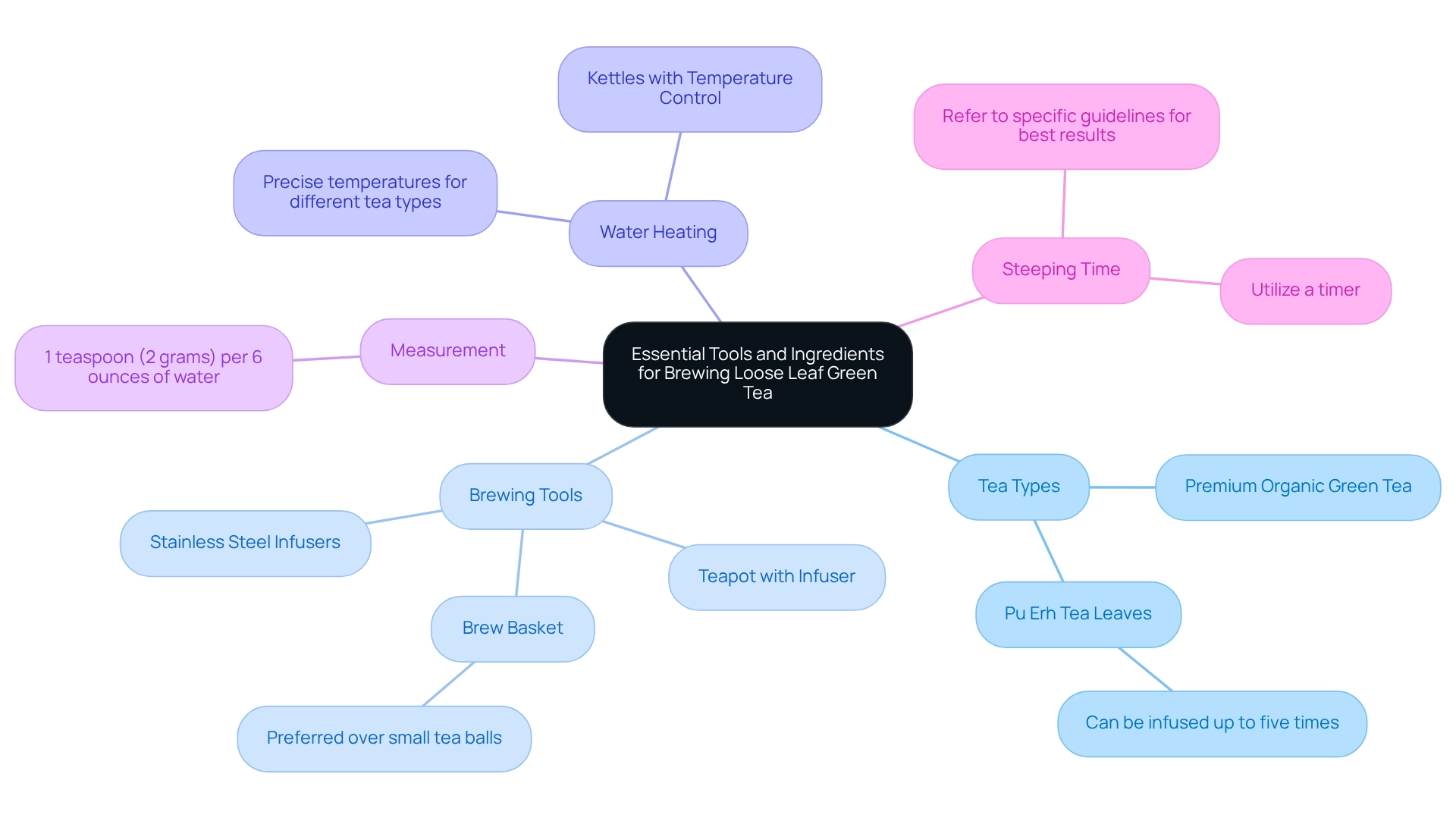
Step-by-Step Instructions for Brewing Loose Leaf Green Tea
To brew the perfect cup of high-quality loose leaf tea, follow these detailed steps:
-
Heat the Water: Start by heating water to the ideal temperature range of 160°F to 185°F (70°C to 85°C). It's crucial to avoid boiling water, as this can lead to a bitter taste in the tea.
-
Measure the green tea loose leaf: For every 6 ounces of water, use approximately 1 teaspoon (2 grams) of USDA Organic and KSA Kosher certified green tea loose leaf. Feel free to adjust this amount based on your personal taste preferences.
-
Pre-warm the Teapot: To enhance the brewing process, pour a small amount of hot water into your teapot or infuser to warm it up, then discard this water.
-
Add green tea loose leaf: Place the measured green tea loose leaf into the pre-warmed teapot or infuser, ensuring they have enough space to expand during steeping.
-
Pour Water: Carefully pour the hot water over the tea leaves, ensuring they are fully submerged to extract the maximum taste and health benefits.
-
Steep: Set a timer for 2 to 3 minutes. At the 2-minute mark, taste the tea to check if it has reached your desired strength. This timing is crucial, as over-steeping can lead to bitterness.
-
Strain and Serve: Once steeped to your liking, strain the tea into your cup, discarding the leaves. Savor your freshly brewed green tea loose leaf, which is rich in antioxidants and flavor, and certified for purity and sustainability!
Research indicates that the antioxidant capacity of green tea can vary significantly based on factors such as harvest season and brewing parameters. For example, spring-harvested brews generally contain higher antioxidant levels than those gathered in the autumn, rendering them a better option for health advantages. Additionally, the polyphenol content, which contributes to the tea's health-promoting properties, is influenced by the growing region, harvest date, and production process.
A recent study utilizing a high-throughput method allowed for the analysis of 1,296 samples within a cumulative time period of less than twenty-four hours, highlighting the efficiency of testing tea quality. Moreover, every batch of the brand's beverages undergoes third-party lab testing to ensure safety and quality, offering you peace of mind with each sip. By following these steps, you can ensure that each cup of Gardenia herbal tea not only tastes great but also supports your wellness journey.
As H.K. noted, the importance of research in understanding tea quality and its health benefits cannot be overstated. Shop Now to explore our range of high-quality green tea loose leaf teas!

Avoiding Bitterness: Tips for Perfectly Brewed Green Tea
To brew green tea without bitterness, consider these essential tips that can truly enhance your experience:
-
Use the Right Water Temperature: It's important to brew green tea with water that isn’t boiling. Aim for a temperature between 160°F to 185°F (70°C to 85°C). This gentle heat helps preserve the delicate flavors while preventing the release of bitter compounds.
-
Steep for the Correct Time: Over-steeping can lead to bitterness, which is something we want to avoid. Aim for a steeping time of 2 to 3 minutes. Taste your tea periodically to discover your preferred strength, as different varieties may need slight adjustments.
-
Adjust Tea Quantity: If your tea consistently tastes bitter, consider using fewer tea leaves. A good starting point is 1 teaspoon of loose leaf tea per 6 ounces of water. This small adjustment can significantly reduce bitterness while still delivering a flavorful cup.
-
Quality of Tea: Always choose high-quality, fresh loose leaf tea. Stale or low-quality tea can contribute to a bitter taste, diminishing your overall enjoyment. Gardenika’s organic sourcing ensures you receive only the finest ingredients, enhancing both taste and health benefits. The astringency of unripe tea is closely linked to the concentrations of ECG and flavonol glycosides, with a correlation coefficient of 0.7878, highlighting the importance of chemical composition in flavor.
-
Experiment: Each variety of herbal tea has its unique characteristics. Don’t hesitate to adjust steeping times and temperatures based on the specific variety you are using. This experimentation can lead to discovering the perfect brew that suits your taste preferences. A recent case study titled "Comparison of Prediction Models for Tea Taste" found that the Back Propagation Neural Network (BPNN) model effectively predicts bitterness and astringency, which can inform your brewing practices.
By following these strategies, you can enjoy a delightful cup of herbal tea that is rich in taste without the unwanted bitterness. Remember, understanding the chemical composition of herbal tea can further enhance your brewing skills. As noted by Hongmei Zhang, the scientific examination of tea brewing and taste profiles is crucial for achieving optimal outcomes.
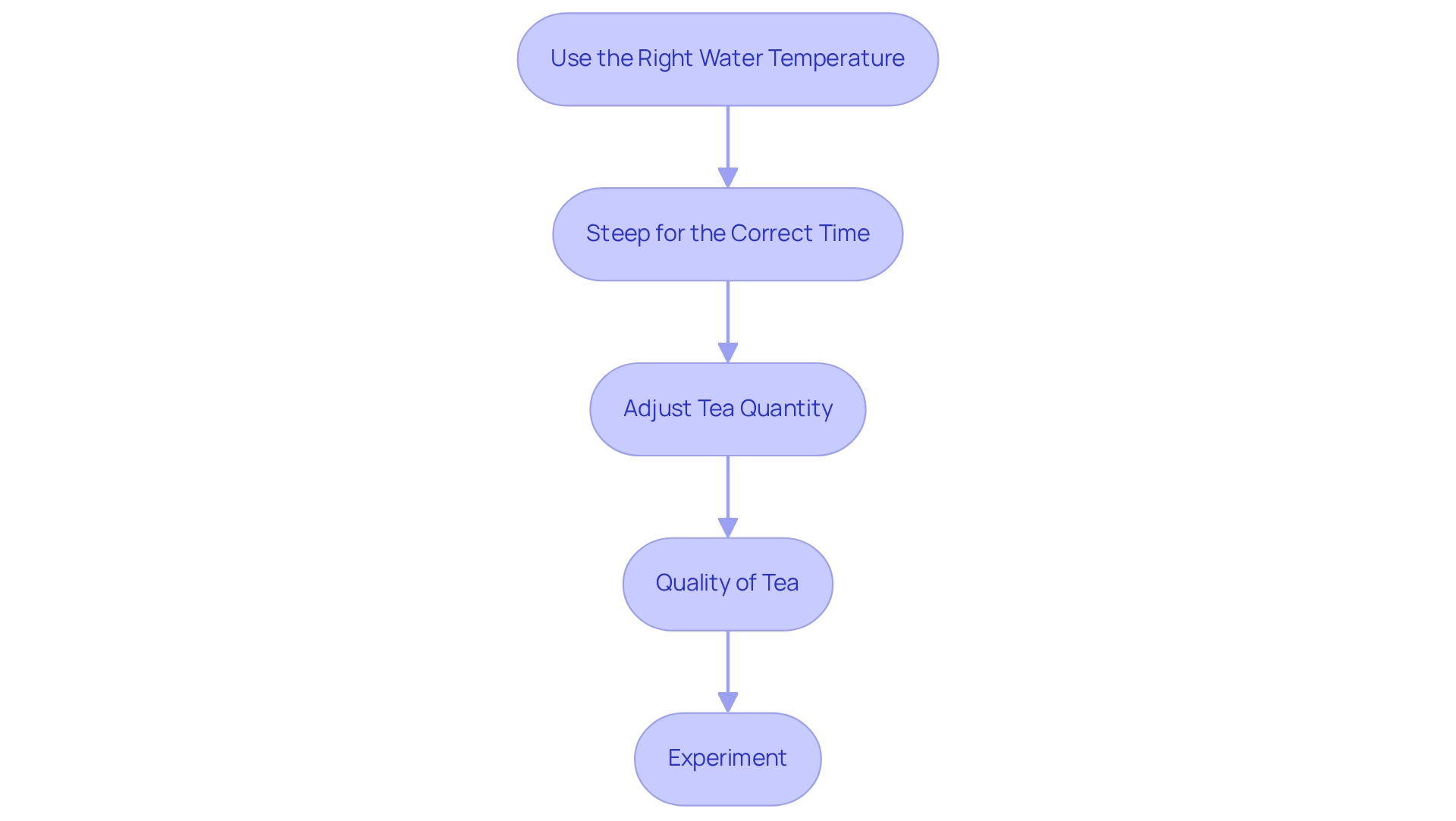
Understanding Water Temperature and Steeping Time for Optimal Flavor
Water temperature and steeping time are essential for extracting the best flavors from green tea, and understanding these factors can truly enhance your tea experience.
Water Temperature: To preserve the delicate nature of tea, it is best brewed with water heated to between 160°F and 185°F (70°C to 85°C). Using boiling water can lead to excessive extraction of tannins, resulting in a bitter taste that masks the tea's natural flavors. Significantly, studies indicate that the EGCG content in herbal tea is 6.96% at 40 °C, highlighting the importance of maintaining suitable temperatures for maximum health benefits.
Steeping Time: The optimal steeping time for green tea typically falls between 2 to 3 minutes. Steeping for too long can lead to astringency and bitterness, while a shorter infusion may result in a weak taste profile. For the best results, start with a 2-minute steep and taste the tea. If the flavor is too mild, gradually increase the steeping time by 30 seconds until you achieve your desired strength.
Multiple Infusions: High-quality herbal teas often allow for multiple infusions. For each subsequent brew, reduce the steeping time by about 30 seconds to preserve the taste integrity while exploring the tea's evolving profile.
Impact of Temperature on Taste: Research indicates that the temperature at which herbal tea is stored significantly affects its catechin content, which is crucial for taste and health benefits. For example, a case study titled "Catechin Stability in Tea Under Different Storage Conditions" found that tea stored at −20 °C retains higher catechin levels (0.59%) compared to those kept at room temperature (0.52%) or 40 °C (0.52%). This highlights the importance of both brewing and storage conditions in maximizing the tea's flavor and health properties.
Cold Brewing: For those sensitive to caffeine, cold brewing tea is a wonderful alternative. This method not only offers a refreshing drink but can also be personalized with fruits and herbs, making it a versatile option for health-conscious consumers.
By paying close attention to these brewing parameters, you can unlock the full potential of your herbal tea, ensuring a delightful and healthful experience with every cup. These techniques align with Gardenika's commitment to quality and health-focused options, reinforcing the brand's position as a leader in the organic tea market. So, why not explore these brewing methods and discover the delightful flavors waiting for you?

Flavoring Your Green Tea: Creative Additions and Variations
Elevate your green tea experience by exploring these innovative flavor additions that can truly enhance your wellness journey:
- Citrus: Imagine a slice of lemon or a splash of orange juice introducing a refreshing twist, enhancing the tea's natural brightness.
- Herbs: Fresh herbs like mint or basil can add a delightful herbal note, creating a refreshing and aromatic infusion that lifts your spirits.
- Spices: Adding a pinch of ginger or cinnamon brings warmth and depth, enriching the overall taste profile and making each sip comforting.
- Sweeteners: For those who appreciate a sweeter cup, honey or agave syrup can beautifully enhance the natural tastes of tea, providing a balanced sweetness that feels just right.
- Fruit: Fresh berries or peach slices infuse your tea with natural sweetness and vibrant taste, making each sip a delightful experience that nourishes your body and soul.
- Experiment: The versatility of green tea invites you to experiment; don’t hesitate to mix and match different ingredients to discover your perfect blend and enjoy the journey of flavor.
With the global hard tea market reaching $2.1 billion in 2022 and expected to expand to $8.7 billion by 2030, there is a clear increase in consumer interest for unique varieties, such as Hojicha and white tea. This trend reflects a broader movement towards diverse tea consumption, aligning with the insights from Sally Lyons Wyatt, who notes that "the many different functional benefits of teas align with consumer needs for mental, physical, and emotional well-being."
As consumer demand for innovative tea experiences increases, these taste enhancements not only cater to individual preferences but also emphasize the significance of creativity in creating a personalized tea experience. The rising popularity of green tea loose leaf highlights the change in consumer tastes, as shown by the substantial increase in inquiries for Hojicha, suggesting a yearning for discovery in tea varieties. Furthermore, recent analyses have revealed various non-volatile compounds in tea, which contribute to umami, astringency, and bitterness, providing a scientific basis for the flavor enhancements discussed. Embrace this journey of exploration and find joy in every cup.
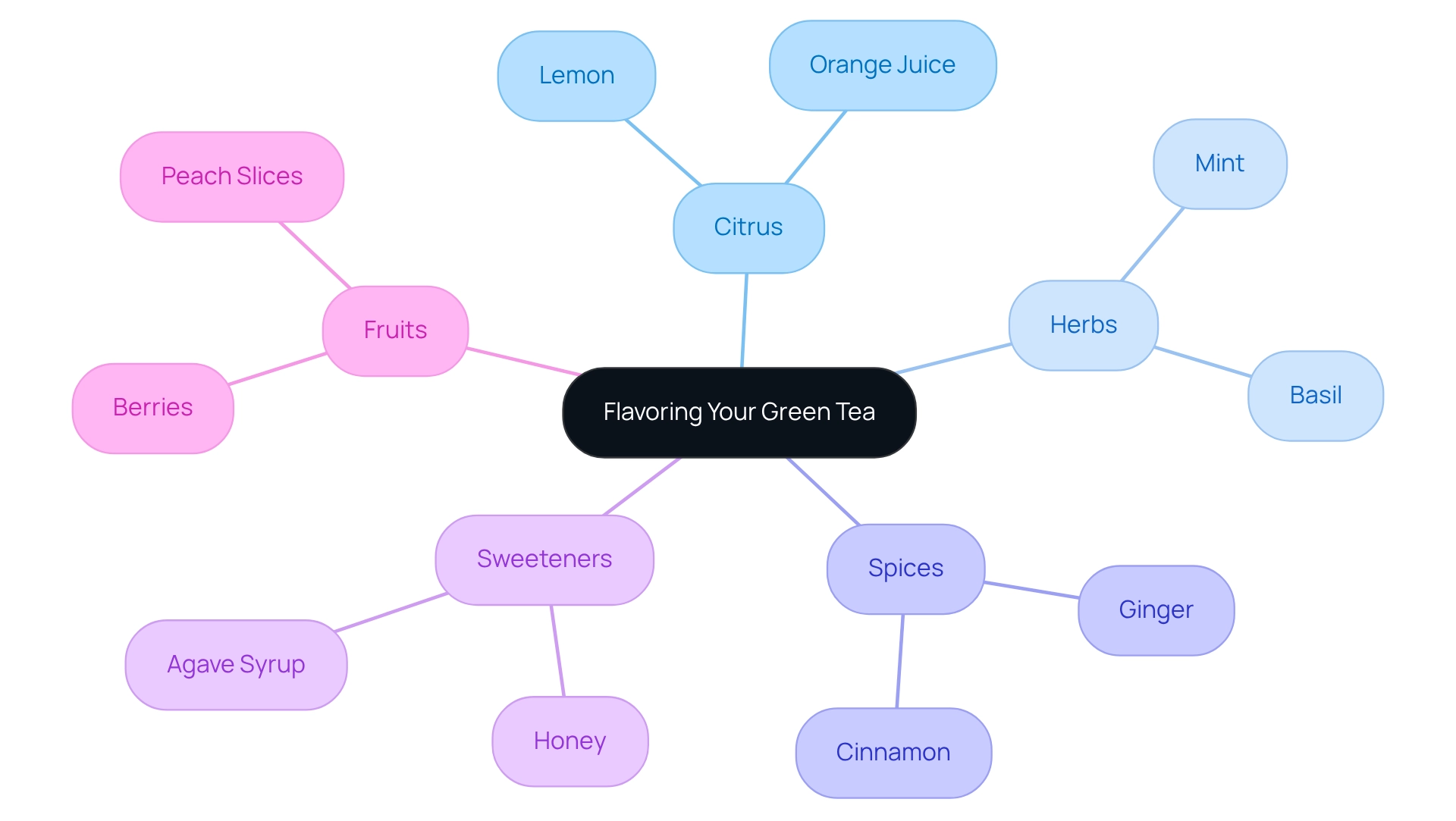
Health Benefits of Green Tea: Why You Should Brew It
Discover Balance with Our Organic Loose Leaf Teas. Preparing herbal tea offers a wealth of health benefits, making it a wonderful addition to your daily routine, especially when you choose premium options like green tea loose leaf crafted with traditional herbs.
Rich in Antioxidants: Our tea is abundant in polyphenols, particularly catechins, which serve as powerful antioxidants that combat oxidative stress and reduce inflammation.
With one of the highest concentrations of antioxidants found in any tea, it plays a significant role in supporting your overall health and wellness.
Supports Weight Management: Research suggests that green tea can boost metabolism and promote fat oxidation, making it a helpful companion in your weight management efforts. Regularly enjoying our organic blends may assist you in achieving your weight loss goals more effectively.
Enhances Brain Function: The unique combination of caffeine and L-theanine in this tea has been shown to improve cognitive function, enhancing focus and alertness. This harmonious blend provides a gentle energy boost without the jitters often linked to coffee, fostering mental clarity and productivity.
Promotes Heart Health: Drinking tea regularly is associated with a reduced risk of heart disease. Studies indicate improvements in cholesterol levels and overall cardiovascular health, highlighting the protective benefits these beverages offer for your heart.
May Decrease Cancer Risk: Some scientific research suggests that the antioxidants in herbal tea may lower the risk of certain cancers. The protective properties of these compounds are believed to inhibit the growth of cancer cells, making our green tea loose leaf a potentially beneficial choice for long-term wellness.
Enhances Mood: The calming qualities of herbal tea can help alleviate stress and anxiety, contributing to better mental health. The soothing blends from our brand are an excellent choice for those seeking tranquility in their daily lives.
Caffeine Considerations: While most people can enjoy herbal tea daily without issues, some may experience sleep disturbances if consumed in large quantities or late in the day. It's important to be mindful of caffeine levels, especially for those sensitive to caffeine or taking specific medications.
Incorporating Gardenika's high-quality herbal tea into your routine not only enhances your wellness but also provides a delightful experience with every cup. Additionally, choosing beverages that are USDA Organic and Kosher certified ensures that you are enjoying a product that meets the highest standards of quality and safety. Explore our selection today.

Proper Storage Techniques for Loose Leaf Green Tea
To ensure your loose leaf green tea stays fresh and flavorful, let’s explore some expert storage techniques that nurture your wellness journey:
-
Use Airtight Containers: Store your tea in opaque, airtight containers. This simple step protects it from light, air, and moisture—elements that can degrade its quality over time. The premium organic loose leaf teas, including the Tulsi Turmeric Ginger and Earl Grey Lavender blends, are USDA Organic certified and kosher certified. By choosing these, you are preserving the highest quality products for your health.
-
Keep Cool: Find a cool, dry spot for your tea, away from heat sources and humidity. Optimal storage conditions can greatly prolong the shelf life of your tea, maintaining its subtle tastes and health advantages—essential features of our health-oriented blends.
-
Avoid Strong Odors: Tea is highly absorbent and can easily take on odors from its surroundings. To preserve its pure flavor, keep it away from spices and other strongly scented foods. This way, you can fully appreciate the wellness advantages of our Ayurvedic blends.
-
Limit Exposure: Try to minimize how often you open the container. Each time it’s opened, the tea is exposed to air, which can lead to oxidation and a loss of taste—compromising the quality that we stand for.
-
Check for Freshness: Regularly assess your tea for freshness. For optimal flavor and health benefits, consume it within a year of purchase. This practice not only enhances your tea-drinking experience but also aligns with our dedication to quality. With over 2000 five-star reviews, Gardenia reflects a strong customer satisfaction rate, showcasing the effectiveness of our products in promoting wellness and balance.
By following these best practices, you can enjoy the full spectrum of flavors and health benefits that green tea loose leaf offers. As Wu De wisely stated, "This is a beautiful inheritance; may we all work together to pass it on!" Proper storage techniques are essential for maintaining the integrity of your tea, ensuring that each cup delivers the wellness and balance you seek.
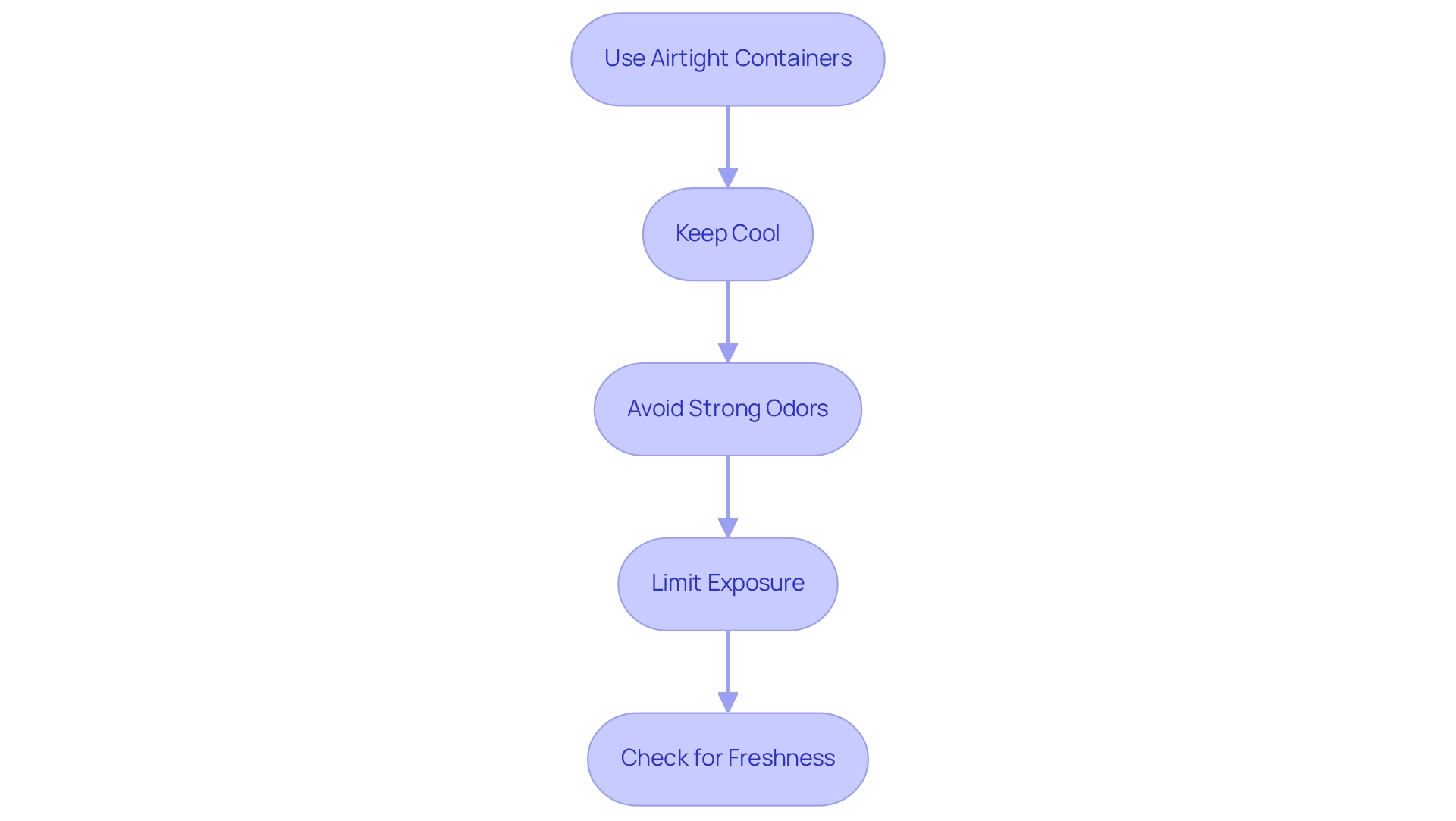
Conclusion
Brewing the perfect cup of loose leaf green tea is a delightful journey, blending art and science. With the right tools, techniques, and ingredients, you can elevate your tea experience. By choosing high-quality, organic tea and utilizing essential brewing tools like a precise kettle and a proper infuser, you significantly enhance the flavor and health benefits of your brew. Remember, understanding water temperature and steeping time is essential; keeping the ideal range of 160°F to 185°F and steeping for 2 to 3 minutes helps avoid bitterness while highlighting the delicate flavors of green tea.
Moreover, don’t hesitate to explore creative flavor additions that can truly elevate your tea experience. Infusing your brew with citrus, herbs, or spices allows for personal expression and enjoyment, catering to your unique palate. This trend towards diverse tea consumption not only enriches your experience but also embraces wellness, as the rich antioxidants and health benefits of green tea contribute to your overall well-being.
Proper storage techniques are vital for preserving the freshness and quality of your loose leaf green tea. By committing to these practices, you ensure that every cup delivers on both flavor and health. Imagine unlocking the full potential of your brews, making each moment spent with a cup of green tea a delightful and enriching experience. Embracing this ritual nurtures your body and fosters a deeper appreciation for the art of tea, inviting you to partake in the rich heritage of this cherished beverage. So why not take a moment to explore the wonderful world of green tea? Your journey awaits!
Frequently Asked Questions
What type of green tea should I use for brewing?
For brewing, it's recommended to use premium organic green tea loose leaf that is USDA Organic and KSA Kosher certified to enhance flavor and ensure sustainability and purity.
Why is it important to use a proper teapot or infuser?
A proper teapot with a built-in infuser or a separate tea infuser allows the tea leaves to expand fully, releasing their rich flavors and beneficial properties, which enhances the brewing experience.
What features should a kettle have for brewing green tea?
A kettle that heats water to precise temperatures is ideal, as different varieties of green tea require specific heat levels for optimal extraction. Kettles with temperature control features can significantly improve the brewing process.
How much loose leaf green tea should I use?
A general guideline is to use about 1 teaspoon (approximately 2 grams) of green tea for every 6 ounces of water to ensure a balanced flavor profile.
Why is using a timer important when brewing tea?
Using a timer helps monitor steeping times and prevents over-brewing, which can lead to bitterness. Proper steeping times vary by tea type, so it's important to refer to specific guidelines.
What is the ideal water temperature for brewing green tea?
The ideal water temperature for brewing green tea is between 160°F to 185°F (70°C to 85°C). Avoid boiling water as it can result in a bitter taste.
What steps should I follow to brew the perfect cup of green tea?
- Heat water to 160°F to 185°F. 2. Measure about 1 teaspoon (2 grams) of green tea for every 6 ounces of water. 3. Pre-warm the teapot or infuser with hot water. 4. Add the green tea loose leaf to the pre-warmed teapot or infuser. 5. Pour the hot water over the tea leaves. 6. Steep for 2 to 3 minutes, tasting at 2 minutes. 7. Strain and serve the tea.
How does the harvest season affect the antioxidant levels in green tea?
Research indicates that the antioxidant capacity of green tea can vary significantly based on harvest season, with spring-harvested brews generally containing higher antioxidant levels than those gathered in the autumn.
How is the quality of the tea ensured?
Each batch of tea undergoes third-party lab testing to ensure safety and quality, providing peace of mind with each sip.





